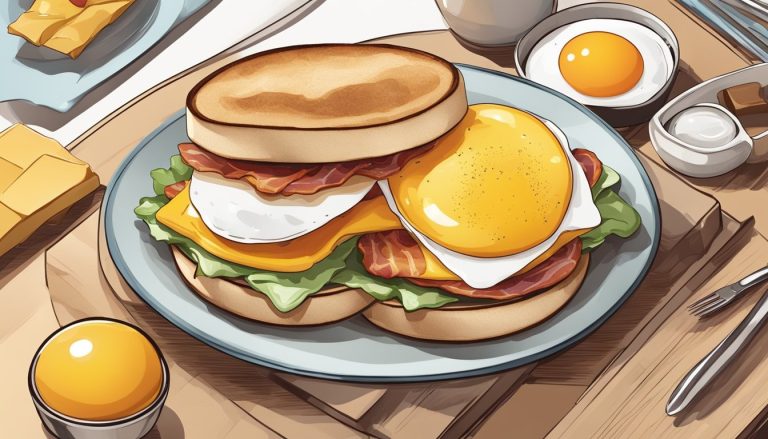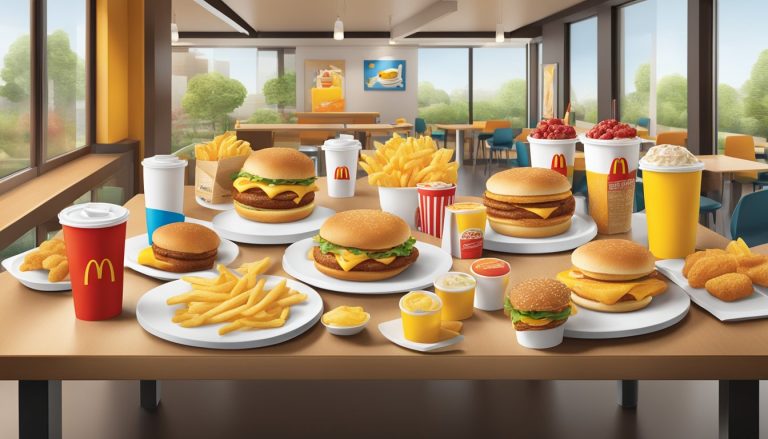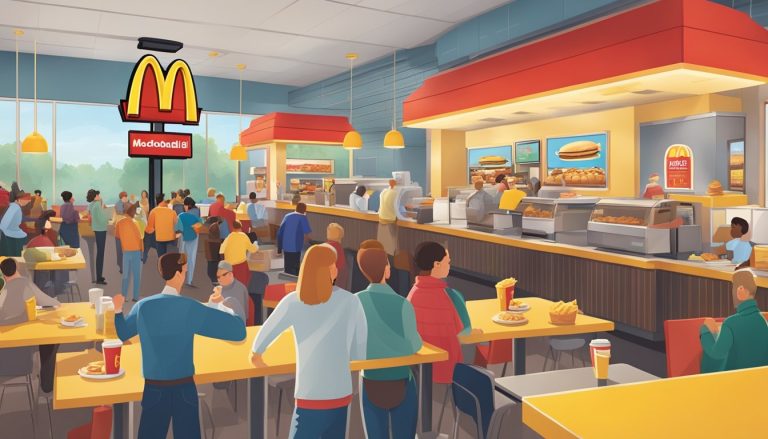Breakfast enthusiasts often debate the differences between hotcakes and pancakes. At McDonald’s, these fluffy discs of goodness are marketed as hotcakes, sparking curiosity about what sets them apart from traditional pancakes. McDonald’s hotcakes are essentially the same as pancakes, with the term “hotcakes” being a marketing choice rather than a reflection of any significant culinary distinction.
The ingredients and preparation methods for hotcakes and pancakes are remarkably similar. Both typically contain flour, eggs, milk, and leavening agents. The batter is cooked on a griddle until golden brown, resulting in a round, flat cake perfect for stacking and topping with syrup or butter.
McDonald’s hotcakes have gained popularity for their consistent taste and texture across locations. They’re made fresh on-site, with batter mixed and cooked to order, ensuring a warm and satisfying breakfast experience. This commitment to quality and convenience has contributed to the enduring appeal of McDonald’s hotcakes as a breakfast menu staple.
Exploring the Fundamentals
Hotcakes and pancakes share similarities but have distinct characteristics. Their definitions, historical roots, and key ingredients form the foundation for understanding these beloved breakfast staples.
The Definition of Hotcakes and Pancakes
Hotcakes are thick, fluffy griddle cakes often associated with McDonald’s menu. They have a denser texture and richer taste compared to traditional pancakes.
Pancakes are thin, flat cakes made from batter and cooked on a griddle or frying pan. They are known for their lighter consistency and versatility in toppings.
Both are circular in shape and served as a breakfast food, but their preparation methods and final textures differ slightly.
Historical Background
Pancakes have ancient origins dating back thousands of years. Early versions were enjoyed by Greeks and Romans, made with wheat flour, olive oil, honey, and curdled milk.
The term “pancake” emerged in English during the 15th century. Over time, recipes evolved across cultures, incorporating local ingredients and cooking techniques.
Hotcakes gained popularity in the 20th century, particularly with the rise of fast-food chains. McDonald’s played a significant role in popularizing hotcakes as a breakfast menu item.
Common Ingredients in Both
Hotcakes and pancakes share several key ingredients:
- All-purpose flour: Forms the base of the batter
- Eggs: Provide structure and richness
- Milk: Adds moisture and helps create a smooth batter
- Sugar: Enhances flavor and promotes browning
- Baking powder: Leavening agent for fluffiness
The proportions and preparation methods may vary between hotcakes and pancakes. Hotcakes often use more leavening agents for extra thickness.
Additional ingredients like buttermilk or vanilla extract can be added to enhance flavor profiles. Some recipes incorporate whole wheat flour for a healthier alternative.
Culinary Techniques and Preparation
McDonald’s hotcakes and traditional pancakes differ in their preparation methods and cooking techniques. These variations result in distinct textures and flavors that set them apart.
Batter Consistency and Texture
McDonald’s hotcake batter is thicker and denser compared to typical pancake batter. This consistency contributes to a heartier texture in the final product. The batter includes ingredients like flour, eggs, milk, and leavening agents, but the exact proportions are a closely guarded secret.
Traditional pancake batter is often lighter and more fluid. It produces a fluffier, more delicate texture when cooked. The difference in batter consistency affects how the cakes rise and spread on the cooking surface.
Cooking Process
McDonald’s uses a specialized flat-top grill to cook their hotcakes. The grill maintains a consistent temperature, ensuring even cooking throughout. Hotcakes are cooked for a precise time on each side, resulting in a golden-brown exterior and a fully cooked interior.
Pancakes are typically prepared on a griddle or in a frying pan. The cooking temperature is usually medium to medium-high heat. Bubbles forming on the surface indicate when it’s time to flip the pancake.
Both hotcakes and pancakes require careful attention during cooking. Proper timing is crucial to achieve the desired color and doneness without burning. The cooking process plays a significant role in developing the distinct characteristics of each type of cake.
Nutritional Profile and Health Aspects

McDonald’s hotcakes and traditional pancakes differ in their nutritional composition and potential health impacts. These differences stem from variations in ingredients and preparation methods.
Ingredient Benefits
McDonald’s hotcakes contain enriched flour, which provides essential B vitamins and iron. The egg content contributes protein and essential minerals like selenium. Milk in the batter adds calcium and vitamin D. Traditional pancakes often use similar base ingredients but may incorporate whole grains for added fiber.
Buttermilk, commonly used in pancakes, offers probiotics that support digestive health. Some recipes include fruit or nuts, boosting antioxidant and nutrient content.
Dietary Considerations
McDonald’s hotcakes are higher in calories and sugar compared to many homemade pancake recipes. A typical serving contains around 590 calories and 16 grams of fat. The syrup adds significant sugar content.
Homemade pancakes allow for more control over ingredients. Using whole wheat flour increases fiber intake. Adding fresh fruits can boost vitamin C and antioxidants. For those with dietary restrictions, alternatives like gluten-free flours or plant-based milk can be used.
Both options can be part of a balanced diet when consumed in moderation. Pairing with protein sources like eggs or Greek yogurt can improve the overall nutritional profile of the meal.
Variations and Cultural Significance
Hotcakes and pancakes have diverse regional variations and cultural meanings worldwide. Their popularity extends far beyond breakfast tables, influencing branding and marketing strategies of major food chains.
Regional Varieties
American pancakes are typically thick and fluffy, made with buttermilk and leavening agents. They’re often served in stacks with butter and maple syrup. Japanese pancakes, known as “hotcakes,” are even thicker and fluffier. They’re made with extra eggs and sometimes mayonnaise for a unique texture.
In France, thin crepes are popular, while Russian blinis are small, yeast-leavened pancakes. British pancakes resemble crepes but are slightly thicker. Each variation reflects local tastes and ingredients.
McDonald’s Hotcakes and Branding
McDonald’s introduced hotcakes to its menu in the 1970s. The company branded them as “hotcakes” rather than pancakes, likely to differentiate their product. This choice aligned with regional preferences in parts of the United States where “hotcakes” was a common term.
McDonald’s hotcakes are thicker and denser than typical pancakes. They’re served with butter and syrup, catering to American tastes. The company’s marketing emphasizes their hotcakes as a hearty, satisfying breakfast option.
This branding strategy has been successful. McDonald’s hotcakes have become a recognizable menu item, contributing to the chain’s breakfast popularity.
Detailed Comparison
McDonald’s hotcakes stand out from traditional pancakes in several key ways. Their unique recipe and preparation methods result in distinctive characteristics and flavors.
Distinguishing Characteristics
McDonald’s hotcakes are thicker and denser than typical pancakes. They have a golden-brown exterior with a soft, fluffy interior. The texture is slightly more substantial, providing a hearty eating experience.
Hotcakes are cooked on a flat griddle at a lower temperature than pancakes. This slower cooking process allows for even heat distribution, resulting in a uniform texture throughout.
The size of McDonald’s hotcakes is notably larger than average pancakes. They come in a stack of three, each measuring about 4 inches in diameter.
Flavors and Toppings
McDonald’s hotcakes have a sweeter taste profile compared to regular pancakes. The batter incorporates additional sugar, giving them a distinct flavor even before toppings are added.
The standard serving includes a pat of butter and McDonald’s signature hotcake syrup. This syrup is maple-flavored rather than pure maple syrup, offering a unique sweetness.
For added customization, customers can request extra butter or syrup. Some locations also offer fruit toppings like strawberries or blueberries as optional add-ons.
McDonald’s often pairs hotcakes with savory sides such as sausage patties or crispy hash browns, creating a balanced breakfast combination.
Consumer Preference and Perception
McDonald’s decision to brand their breakfast item as “hotcakes” rather than “pancakes” has influenced consumer perception and preferences. This naming choice sets their product apart in the crowded breakfast market.
Many customers associate McDonald’s hotcakes with a specific taste and texture experience. The term “hotcakes” evokes images of warm, freshly made treats, which can be more appealing than the generic “pancakes.”
Brand loyalty plays a significant role in consumer preference. McDonald’s regulars often seek out hotcakes specifically, viewing them as a distinct product rather than just another pancake option.
The perception of hotcakes as a unique McDonald’s offering can lead to increased sales. Customers may choose McDonald’s over other establishments specifically for this menu item.
Marketing and packaging also contribute to consumer perception. McDonald’s presents their hotcakes in a distinctive manner, further differentiating them from typical pancakes found elsewhere.
Taste preferences vary among consumers. Some prefer the flavor profile and texture of McDonald’s hotcakes, while others may favor traditional pancakes from other sources.
Convenience is a key factor in consumer choice. McDonald’s hotcakes are readily available and consistently prepared, which appeals to customers seeking a quick, reliable breakfast option.
Improving and Customizing Recipes
Experimenting with pancake and hotcake recipes allows for endless creativity and personalization. Home cooks can adapt classic formulas to suit different tastes and dietary needs.
Innovative Uses of Pancakes and Hotcakes
Pancakes and hotcakes extend far beyond breakfast. They can be transformed into savory lunch wraps filled with vegetables and proteins. For a unique twist, try using pancake batter to coat and fry foods like chicken or fish.
Miniature pancakes make excellent hors d’oeuvres when topped with smoked salmon or caviar. Leftover pancakes can be repurposed into bread pudding or used as layers in a cake.
Hotcakes work well in casseroles or as a base for eggs benedict. Their sturdier texture allows them to hold up to heavier toppings and sauces without becoming soggy.
DIY Options for Health-Conscious Individuals
Health-conscious individuals can modify pancake and hotcake recipes to align with their dietary goals. Whole wheat flour or almond flour can replace all-purpose flour for added nutrients and fiber.
Greek yogurt or mashed bananas can substitute for oil to reduce fat content. Adding chia seeds or ground flaxseed boosts omega-3 fatty acids and fiber.
For protein-rich options, incorporate protein powder or egg whites into the batter. Vegetables like grated zucchini or carrots add moisture and nutrients.
Sugar alternatives such as stevia or monk fruit sweetener can reduce calorie content. Topping pancakes with fresh fruit instead of syrup provides natural sweetness and additional vitamins.
The Role of Hotcakes and Pancakes in a Beauty Regimen

Hotcakes and pancakes, traditionally enjoyed as breakfast foods, offer surprising benefits for skincare when used topically. Their ingredients contain properties that can nourish and improve skin health.
Natural Ingredients for Skincare
Raw cacao, often found in chocolate chip pancakes, is rich in antioxidants. These compounds help combat free radicals and oxidative stress, potentially reducing fine lines and wrinkles. Cacao also promotes blood circulation, enhancing skin elasticity and imparting a youthful glow.
Buttermilk, a common pancake ingredient, contains lactic acid. This mild alpha-hydroxy acid offers gentle exfoliation properties, improving skin texture and radiance. It may help reduce blemishes and redness, particularly beneficial for acne-prone skin.
Sweet almond oil, sometimes used in hotcake recipes, acts as an emollient. It hydrates the skin, potentially boosting collagen and elastin production. This natural oil is suitable for sensitive skin types and may help soothe irritation.
Benefits Beyond Breakfast
Pancake batter ingredients like eggs and milk provide proteins that support cell repair and rejuvenation. These nutrients can contribute to improved skin elasticity and a smoother complexion when applied topically.
The mineral content in pancake flour, including zinc and selenium, may offer protective benefits against sun exposure damage. These minerals support overall skin health and can aid in maintaining a clear complexion.
Honey, a popular pancake topping, has natural anti-inflammatory properties. When used in skincare, it may help reduce redness and soothe irritated skin. Its humectant properties also assist in skin hydration, promoting a plump and supple appearance.




